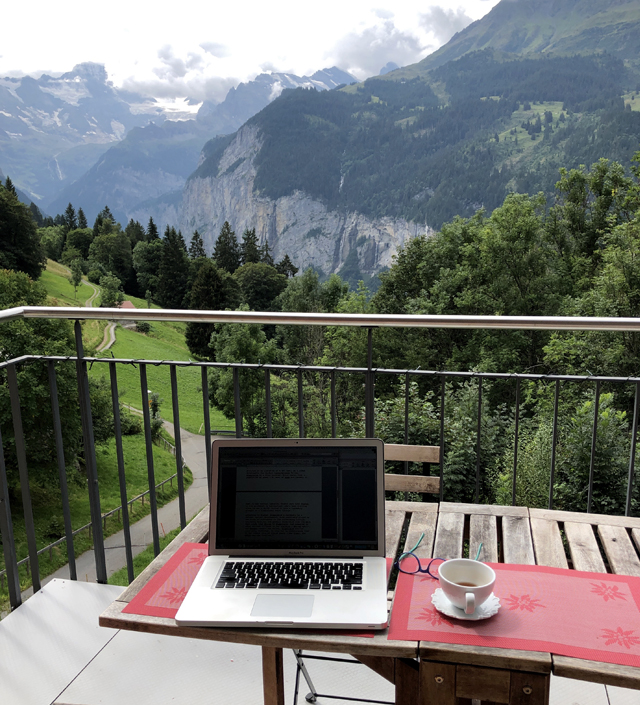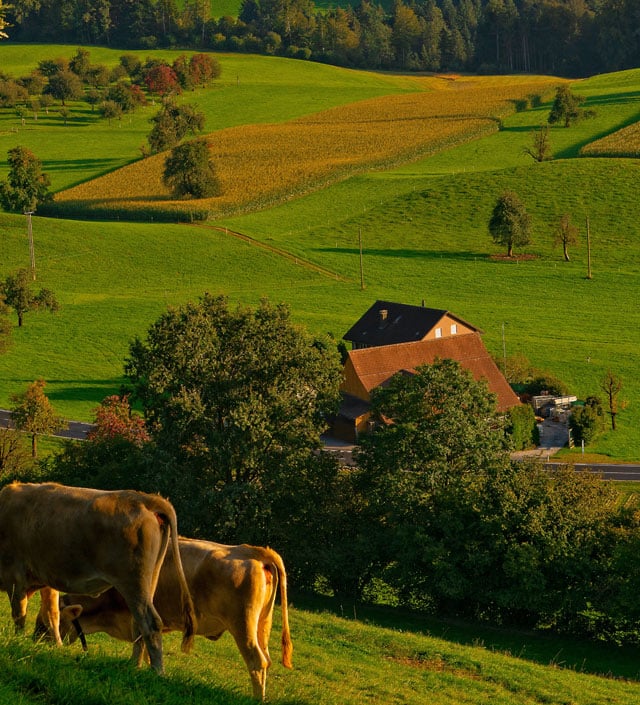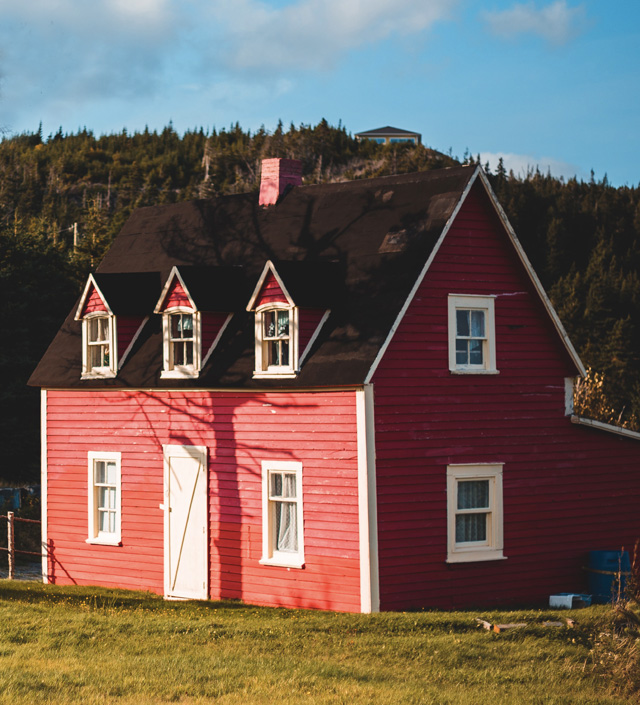For many years, as I devoured books about Americans who had owned homes in Europe, I wanted to be one of them. The sharing economy has given me a better alternative: the chance to build a portfolio of European properties that I like enough to rent repeatedly but wouldn’t want to own.
It’s a strategy my husband and I have pursued for six autumns, with a one-year hiatus due to the pandemic. During that time we have had lengthy stays (up to six weeks) in dozens of houses and a few apartments, mostly in rural areas. Highlights have included an 18th-century Normandy château where we cocooned for the first two weeks of September this year; an exquisite triplex in a former Basque shipbuilder’s mansion at the foot of the Pyrenees; and a 14th-century cottage on the ramparts of a medieval Dordogne village. And we’re always looking to expand our “portfolio” with additional places where we can stay on future visits.
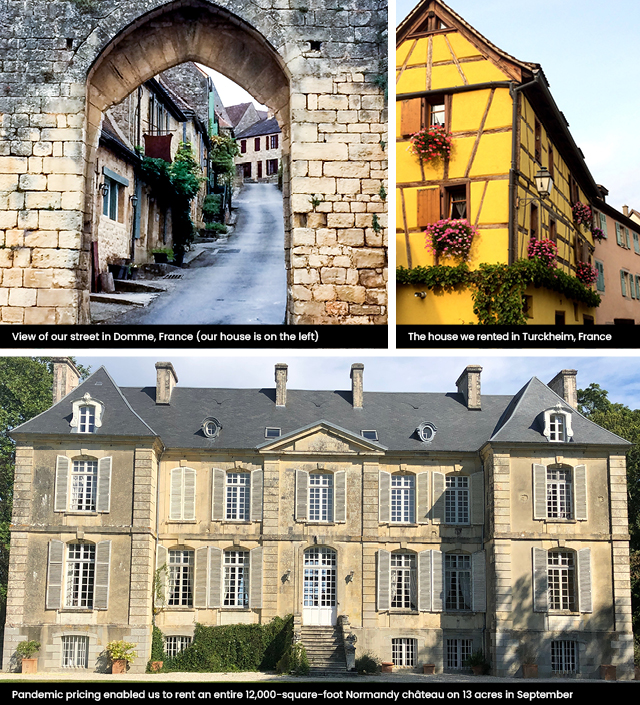
Though this may sound like an unusual plan for what I prefer to call my unretirement, it makes sense from a financial, legal and practical perspective. The pandemic gave us one more reason: As the world shut down due to Covid-19 in March 2020, many foreign nationals had the expense of maintaining European homes they couldn’t even visit. We had none of their burdens and were free to return once borders reopened. When that happened about one year later, we started making plans.
Repeat Choices
Our first stop in a ten-week sojourn was a portfolio apartment in Wengen – a carless village in the Bernese Oberland region of Switzerland that we had occupied on two previous visits. Managed by a local real estate agent, it’s owned by a British couple about our age. Apart from their name, which is on the mailbox, we know little about them except that, judging by the exceptionally well-equipped kitchen, they like to cook.
What keeps us coming back to this two-bedroom, two-bath dwelling is its panoramic view of the Jungfrau – the highest of three prominent mountains in the area. As my husband threw open the French doors and stepped out onto one of our three balconies, he said, “I can feel 18 months of tension start to leave my body.” We fell asleep to a symphony of cowbells and felt like we had come home.
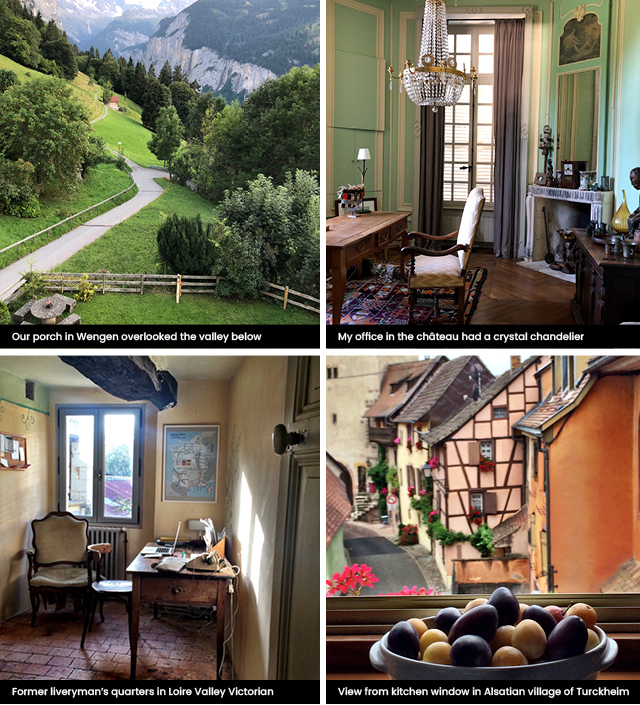
Other places we’ve rented at least twice include an 18th-century half-timbered house on the old stone wall of an Alsatian village; an apartment in a residential neighborhood of San Sebastián, Spain; and another overlooking the water in Getaria – an active fishing village along the Spanish Basque coast. This one, too, has a million-dollar view, and we took refuge there for three weeks during the pandemic.
It’s a property we discovered through Airbnb, and we have become friends with the host – a high school science teacher who lives about an hour away and spends the summer in Getaria. From this apartment, on a cliff overlooking the village, we can hear the waves, see surfers from dawn to dusk and observe the twinkling lights of fishing boats at night.
12,000-square-foot Castle
Most of the houses we rent are charming old family homes, rather than Ikea-furnished investment properties, which sometimes leaves me wishing those walls could speak. For example, when Normandy and much of France had been occupied by the Germans during World War II, the château we rented this year would have been an obvious place for soldiers to have lodged. A few bullet holes were still visible on the exterior.
Our Airbnb host had provided scant details. A World War I hero who owned the premises “was allowed to remain at the château throughout the war and was present in June, 1944 when the D-Day landings took place 30 km to the north,” he wrote in a message welcoming us to the premises. Subsequent owners had reportedly included a Tunisian entrepreneur, who turned it into a retirement home, and a Parisian couple who meticulously restored various 18th-century details.
Spending time around this 12,000-square foot castle, situated on 13 acres with its own orchard, was part of the fun during the Normandy segment of our recent sojourn. Each morning, from the bathtub, I watched cows grazing on the adjacent property. We picked Mirabelle plums from the fruit trees (there were also apples and pears) and prepared homemade jam. And on balmy September evenings we sipped aperitifs in the garden. Such pleasures made us willing to forgive some otherwise irksome quirks, like faucets that only ran cold – not hot – and the trip hazard of broken antique floor tiles in the upstairs hallway that ran the width of the house.
Though we would gladly return, this property might have been a one-off, since at the time we booked, in late May, the American owners were offering a greatly discounted rate due to the pandemic. Wanting to go back to that region next spring, we spent our final day there looking at real estate and booked another house that might turn out to be a more affordable addition to our portfolio.
Eiffel Tower View
Following several negative experiences with Paris apartments, including a rental that fell through two weeks before our 2019 arrival, we happened upon a 600-square-foot treasure in the 16tharrondissement. From the kitchen window, half the Eiffel Tower jutted out above the Paris rooftops. The cabinets were filled with fine crystal and ceramic serving pieces. And the living room walls were adorned with original paintings by an obscure avant-garde artist who had been a friend of the owners.
We learned belatedly that they had lived in the apartment since it was built in the early 20th century, and raised three children in this tiny space. Our Airbnb host was their grandson.
In a phone interview after our return to the United States, he told me that he had initially rented the apartment to finance nursing home care for his grandfather, who had recently died. His grandmother, who predeceased her husband, had been a member of the French Resistance. His recollections, about school lunch breaks spent with his cousins at the dining room table and the foods his grandmother prepared, made our experience there even more meaningful.
Surprises, Bad and Good
Since the goal of our extended stays is to live in each place, rather than to tour all the time, comfort and ambiance are more important to us than they might be to those who spend all day sightseeing. Though online photos and reviews rarely tell the whole story, we scrutinize them in an effort to avoid unpleasant surprises – about nearby noise, lumpy beds or pigeon infestations, for example. Unfortunately they didn’t reveal that, notwithstanding the gorgeous mountain view and well-tended garden at our Basque Country rental this year, the furnishings were so grungy that we hated to be indoors.
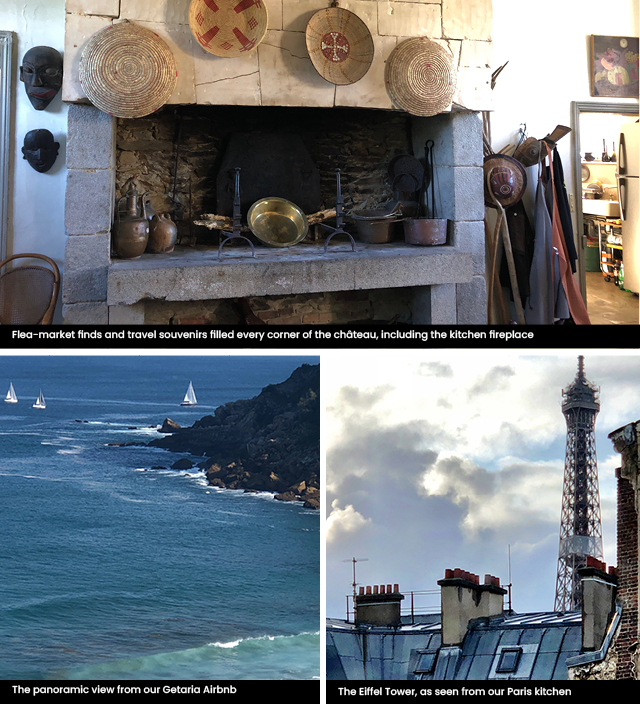
But every rental also carries the promise of pleasant surprises. We look forward to what awaits us at each new place, and the possibility that it, too, might qualify as a portfolio property. That’s how we felt upon discovering the partial view of the Eiffel Tower from the Paris apartment, ripe plums in the orchard at the Normandy château and expansive kitchens at several other French country rentals.
Though I can set up my laptop anywhere, it’s a bonus if there’s an office, or a bucolic outdoor space where I can write. In the Normandy château, the owner’s stylish office, with its original herringbone parquet floor, crystal chandelier and view of the rose garden, became my workspace. At a rambling Victorian in the Loire Valley surrounded by vineyards, I turned the former liveryman’s quarters, with its terra-cotta floor and stenciled walls, into my office. In a former forge in Salles, a tiny village in the Tarn region of France, I sat in the shade of a fig tree where ripe fruit practically plopped on my head as I typed.
One house that didn’t make it into our portfolio, in the medieval French village of Domme, was along the route of something called “Le Petit Train.” This is a sightseeing vehicle (with commentary) that looks like a giant toy train. Several times a day Le Petit Train passed directly in front of our otherwise blissful Dordogne rental – a former restaurant with a valley view out the back. And when it did, we were nearly nose-to-nose with curious onlookers staring into our windows.
Though we’ve returned to that region three more times, spending a total of several months there, we have yet to find a portfolio property. That’s partly because this is a popular second-home region, and there are so many homes to choose from. Another factor is that we’ve enjoyed sampling different villages, each with a very different vibe. After staying in seven different houses, all no more than 45 minutes from each other, our hunt for a portfolio property in the Dordogne has become a pleasant pursuit.
What We’ve Learned
If there have been times when I’ve missed my own possessions – most notably when cooking in other people’s kitchens – they’ve been outweighed by the intrigue of curiosities found on the premises, from books and bric-a-brac to premium cookware.
For convenience, I also bring along a packing cube with what I call my “field kitchen.” Its contents include two high-quality kitchen knives; a dependable vegetable peeler and corkscrew; a pair of bamboo tongs; and an apron. Occasionally I buy inexpensive equipment and leave it behind for the owner or next traveler – which might be us on our return to a portfolio property. At our Getaria lodgings this year I used the salad spinner and fine-mesh strainer that I purchased the last time we stayed there, in 2019.
One payoff of repeat visits is knowing our way around when we come back, and not just in one country or region – as it would be if we owned just one place – but in multiple locations where we have portfolio properties. We also chart a course with weather conditions in mind, beginning our autumn trips in Switzerland, and heading south as the weather gets cooler.
Though we travel light across the Atlantic, we rent a car early in the journey, which enables us to move easily between regions and fill the trunk with specialties from each – for example, Riesling from Alsace, butter from Normandy and Comté cheese from the Jura.
In each region we have favorite routines, whether it’s hiking in Wengen, strolling through Alsatian vineyards during the grape harvest, or going to weekly markets in the Dordogne. In Getaria, we inhale the smell of eucalyptus along the pedestrian path to a neighboring village; check out the latest flavors at the artisan ice cream shop where the owner greets us warmly; and head down to the fish store at the port to see what’s fresh. I’ve learned most of what I know about cooking fish from daily interactions with Marijosa, the fishmonger.
We’ve made friends along the way, too. Our landlady from the former Basque shipbuilder’s mansion, where we stayed for six weeks in 2015, hasn’t been able to host us again; for the past two years her adult daughter and family have been living in the attached apartment that she used to refer to as votre maison (your house). But we routinely get together with her and her husband.
Why We Don’t Buy
Now and then we still toy with the idea of buying, but the scales always tip against it. For starters, the legal and financial complications seem mind-boggling. Getting a mortgage raises the tricky question of which currency to borrow in. Owning a European home could subject us to extra layers of taxes. With very limited exceptions, Medicare won’t reimburse you for expenses overseas; so unless we became European residents, we would have to buy additional, costly health insurance. And likewise under the Schengen Agreement, non-residents can’t stay in the European Union longer than 90 consecutive days within a six-month period, unless they get a special visa.
Finally, if there came a time when we couldn’t make this journey because of health issues, or didn’t want to for family reasons (say due to the arrival of grandchildren), a European home could become a liability.
Now that we have portfolio properties in multiple locations, we would rather not commit to only one place, either. Not to mention the aggravation of having to manage a home from afar, especially if we rented it to others when we weren’t using it ourselves. And though those books about gut-renovations of European homes can be amusing, they don’t make it sound like much fun.
Additional Reading: Trading Places
The latest reports about the Omicron variant, and the threat of new European restrictions make us especially glad to be unencumbered. We returned to New York just ahead of the news, in time to host Thanksgiving at the one home that we actually own. After living in unfamiliar houses, we are rediscovering its pleasures. This will be a cozy place to spend the winter, and dream about the portfolio properties where we hope to return in the spring.
Deborah L. Jacobs, a lawyer, entrepreneur and award-winning journalist, is a former senior editor at Forbes. She is the author of “Four Seasons in a Day: Travel, Transitions and Letting Go of the Place We Call Home” and “Estate Planning Smarts: A Practical, User-Friendly, Action-Oriented Guide.” Follow her on Twitter at @djworking and join her on Facebook here.



